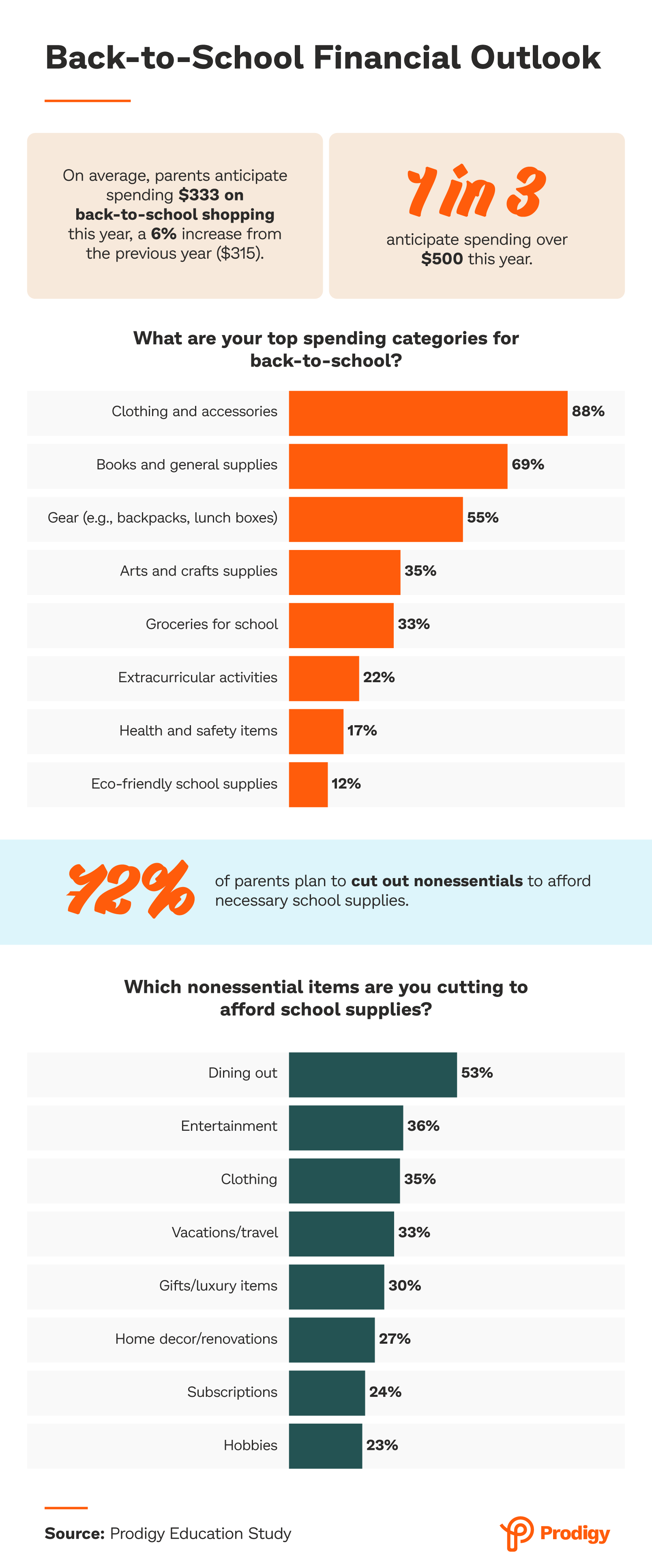What Parents Plan To Spend on Back-to-School - Prodigy Education

Before the school bells ring once again, parents across the nation are gearing up for the annual back-to-school shopping marathon. But this year, with inflation and budgets tightening, families are facing new challenges in equipping their children for the academic year ahead.
Our comprehensive study, surveying 1,007 parents of K-8 students in 2024, explores their financial hurdles, shopping trends, and creative solutions in this critical season. From the adoption of AI tools to the reliance on community support, here's how parents were handling back-to-school preparations in 2024.
Key Takeaways
- On average, parents anticipated spending $333 on back-to-school shopping in 2024, a 6% increase from the previous year ($315).
- Nearly 1 in 4 parents planned to buy secondhand or used items to reduce costs.
- 1 in 9 parents reported being unable to afford everything on their back-to-school list.
- 65% of parents said the main back-to-school shopping challenge is rising costs due to inflation.
- 68% of parents believed that some required school supplies are unnecessary.
- Nearly 1 in 5 parents thought they would rely on community programs or social support to help with back-to-school expenses.
Back-to-School Costs

In 2024, back-to-school costs are on the rise. The parents we surveyed anticipated spending an average of $333 on back-to-school shopping, marking a 6% increase from 2023's $315. This uptick in expenses led to some strategic back-to-school planning, with Gen Z parents the most proactive: 82% of them planned to cut nonessential expenses to afford necessary school supplies.
Here's a breakdown of the average anticipated spending across categories during 2024 back-to-school:
- Clothing: $171
- School supplies: $85
- Gear (backpacks, lunch boxes, etc.): $57
You might notice that technology didn't make the list. Most parents (3 in 4) weren't planning to spend on tech items, likely because many U.S. schools provide students with devices like laptops and tablets. However, some parents were looking beyond the supplies above: 1 in 12 said they plan to invest in tutoring services.
Location correlated with some variation in spending patterns. Urban parents expected to spend the most ($348), followed closely by suburban parents ($333), while rural parents anticipated spending slightly less ($320).
The differences became even more pronounced when we looked at specific metro areas. Among the U.S. cities in our study, the Top 5 with the highest average planned spending were:
- Houston, TX: $443
- Tampa, FL: $375
- Indianapolis, IN: $372
- New York, NY: $360
- Portland, OR: $360
On the other end, some cities had considerably lower anticipated expenses. The cities with the lowest average planned spending were:
- Detroit, MI: $248
- Kansas City, MO: $264
- Miami, FL: $277
- Orlando, FL: $279
- Washington, D.C.: $294
These figures highlight the significant variation in back-to-school costs across the country, with some parents facing nearly double the expenses of others depending on their location.
School Shopping Trends
Beyond what parents want to buy and how much they'll spend, we also wanted to know how and when they'll make their back-to-school purchases. These are the most common shopping strategies and timing preferences of today's budget-conscious parents.

Nearly 25% of parents said they plan to buy secondhand or used items to reduce costs, highlighting a growing focus on budget-friendly options. Another 10% of parents reported plans to leverage AI tools for creating back-to-school shopping lists. Gen Z parents were at the forefront of this tech-savvy approach, with 15% likely to use AI assistance.
As for purchase timing, parents had varied preferences for when to start their back-to-school shopping. Here's when parents said they'll begin their school supply hunt:
- June or earlier (13%)
- July (41%)
- August (44%)
- September (1%)
Most parents (85%) preferred to start shopping in July or August, and very few will likely leave it to the last minute in September.
Top Back-to-School Season Challenges
Preparing for the new academic year isn't easy – it often involves a variety of obstacles beyond simply checking items off a list. This part of our research reveals the financial strains and resource-seeking behaviors that characterize the modern back-to-school experience.

Rising costs due to inflation emerged as the primary challenge for 65% of parents when tackling back-to-school shopping. Financial pressure like this has led to some concerning outcomes, with 1 in 9 parents reporting they couldn't afford everything on their back-to-school list. Gen Z parents were hit hardest, with 23% unable to purchase all the items they'll need.
To cope with these challenges, nearly 1 in 5 parents said they'd rely on community programs or social support for back-to-school expenses. Again, Gen Z parents showed the highest need, with 38% planning to use these resources.
Depending on the school district, school supply expenses may be the responsibility of parents, teachers, or local budgets. Some schools cover all these costs, while others charge fees.
Sometimes, there's a disconnect between school expectations and family budgets: 68% of parents believe that some of the required school supplies are unnecessary. This perception can add to the stress of an already challenging shopping season.
Ready for the 2025 School Year?
The modern back-to-school season is a balancing act of financial planning, resourcefulness, and community support. Parents are getting creative and strategic in their approach to school preparation, from using technology for shopping lists to seeking secondhand solutions. But they're also experiencing financial strain this time of year – particularly younger parents.
As we move forward, addressing the rising costs of back-to-school essentials will be key to ensuring equal opportunities for all students. After all, a child's education shouldn't be determined by their family's ability to navigate an increasingly expensive shopping list.
Methodology
For this campaign, we surveyed 1,007 parents of K-8 students to explore the financial challenges, trending supplies, and overall concerns they face during back-to-school shopping.
The generational breakdown was as follows:
- Gen Z (4%)
- Millennials (69%)
- Gen X (26%)
- Baby boomers (1%)
About Prodigy Education
Prodigy Education is a global leader in game-based learning. Our mission is to help every student in the world love learning, motivating millions worldwide via fun, secure, and accessible curriculum-aligned gameplay experiences. At Prodigy Education, we believe maximizing student motivation helps develop a lifetime love of learning. Prodigy's approach to fun, game-based learning means kids no longer have to choose between homework and playtime. Visit www.prodigygame.com to learn more.
Fair Use Statement
We encourage you to share these findings for noncommercial use; please attribute the original source with a link.











